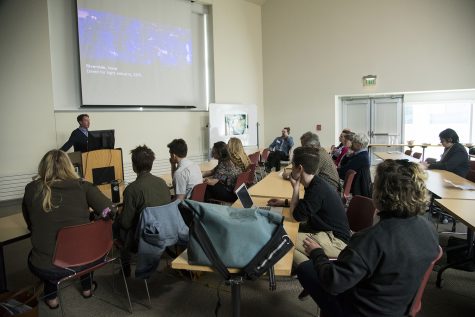UI Ombudsperson Office manages new location and outreach
On the heels of a move to the Jefferson Building, the Office of the Ombudsperson continues to adapt to the ever-changing needs of the UI population.
The Jefferson Building is seen on Tuesday, April 23. The Building, which is located on E. Washington St., now houses the University of Iowa Office of the Ombudsperson.
April 25, 2019
Ombudsperson, which comes from a Swedish term that means “representative,” is not commonly used in the English vernacular — but when students and staff members at the University of Iowa need assistance with concerns ranging from missing class to sexual assault, this word is the one they need the most.
Before March, the UI Office of the Ombudsperson was housed in Seashore Hall, but because of the building’s impending demolition, the office was moved to the Jefferson Building at 129 Washington St.
In a statement to The Daily Iowan, UI Media Relations Director Anne Bassett said several things go into consideration when contemplating the move of an office or department.
“For instance,” she said. “The Office of the Ombudsperson was located in Seashore Hall, so there was an immediate need to find another location. Campus Planning also needed to make sure the new space could appropriately accommodate the privacy function of the office, which is something the Jefferson Building could provide.”
The new home, nestled on the third floor above a Subway restaurant, has allowed the office to expand its operations, Ombudsperson Cynthia Joyce said.
“We’re not alone in moving — the [demolition] of Seashore Hall means that many offices are moving,” she said. “But we did increase our staff a few years ago, and Seashore became constricting, so it was a great move for us.”
The UI has had an Ombudsperson Office since 1985, Joyce said, and has served thousands of students since then. But one concern that has beleaguered the office, she said, is outreach to undergraduate students.
RELATED: Ombudsperson office released annual reports on demographics of people seeking help
“It is very difficult for us to do outreach to the undergraduate population for a number of reasons,” she said. “It’s a large population, and they’re only here for four years. But with that said, we encourage students to come to us with any concern they have.”
According to the office’s most recent report, 51 percent of visitors during the 2017-18 school year were staff members. Only 25 percent of visitors were students, which has remained fairly consistent for the last five years, and faculty made up 17 percent. Overall, Joyce said, the number of visitors has steadily increased since the office’s inception.

“A lot of people are intimidated by our name, and there is this large misconception that issues brought to the Ombudsperson Office have to be large issues,” Joyce said. “If you’re a student living in a residence hall and you are having problems with your roommate, we may not be your first call, but we deal with a wide range of issues.”
The breadth of issues, according to the same office report, deal with a wide range of issues — 50 percent of visits dealt with issues with authority, and 11 percent dealt with peer relationships.
Professor Rachel Williams, who was appointed to serve as an ombudsperson in 2018, said there are challenges associated with a move, but the core mission of the office has not changed.
“If we see that something is not a fair policy or a policy is not being followed, we will mediate those conflicts and point people toward the right resources,” she said. “Sometimes, people just need to be heard.”





















